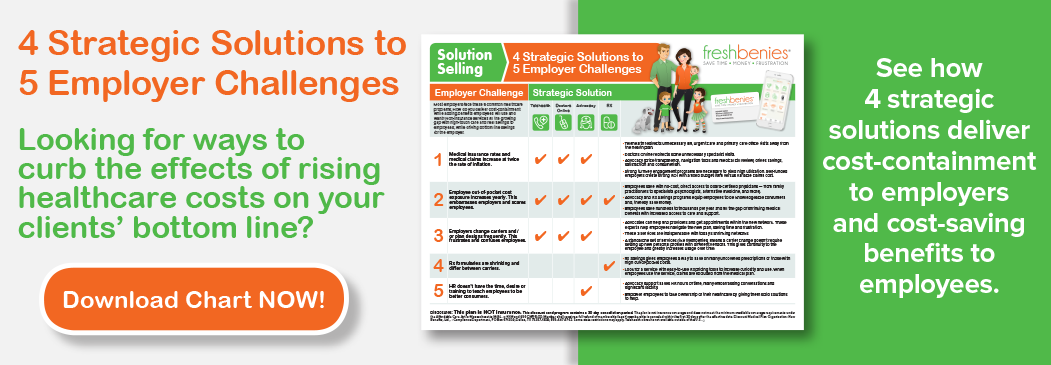WHAT EVERY SELF-FUNDED GROUP NEEDS: 2 TRENDS + 1 SOLUTION
The following article by Jo Ann Vernon first appeared in the May 2017 edition of "California Broker Magazine." Jo Ann serves as freshbenies Broker Sales Executive to the West.
How many of your clients are considering self-insurance? It’s gaining popularity among a wider variety of employers – even around the Pacific and Mountain time zones where groups have been slower to adopt self-funded options.
What does this mean for your client conversations? I’m sharing two trends and one critical component for every client considering a move to a self-insurance arrangement…
Trend #1 – Self-funding isn’t just for larger employers
Perhaps the most notable change in this movement toward self-funding is the number of smaller employers getting in the game. Although most of these are level-funded arrangements, employers see the value in gaining control of their plan with a focus on what’s important to their specific employee base. Plus, the tax advantage isn’t bad either as state taxes are eliminated on most self-insured plans.
TIP! Be sure to help your clients choose the right Third Party Administrator (TPA) for claims adjudication. The efficiencies gained from the right partner will only increase the effectiveness of reducing costs to the plan. Click hereto read a recent article that makes this point (and others).
Trend #2 - PPO and HDHP plans are the most popular
As noted in this Kaiser Family Foundation study, most self-funding employers are choosing either a PPO or HDHP plan. You probably agree the reasons for an HDHP choice appear obvious. For me, the popularity of the PPO option is particularly interesting. Wouldn’t an HMO seem to be the more likely choice? Managed care is a common way to control costs, it keeps the network narrow and a tight rein on how benefits are accessed. But when groups are looking to self-insure, they’re considering what their employees value most – and it’s still about choice and the ability to access care in a manner that works best for them. That’s why the PPO ranks high among groups moving to a new self-insurance arrangement.
TIP! While employers want to offer choice to their workers, they also want employees to use their health plans in order to avoid unnecessary claims that hit the company’s bottom line. Including an advocacy benefit is a great fit for both needs. Employees get an expert to help them with things like comparing costs before procedures, locating in-network providers/specialists, and negotiating bills. The need for such services is highlighted in this recent survey of employees with high-deductible plans. With advocacy, employers see the savings because employees are equipped to make informed buying decisions. The average worker doesn’t know the cost of their MRI may vary greatly within a 15 mile radius. However, their health advocate can do the research and provide them with this valuable information. That’s a real benefit and a real savings!
Solution! Consumerism tools: something every self-insured client needs
Whether partially funding or fully self-insured, employers need to protect the plan and their employees from high out-of-pocket costs. When consulting with your clients, it’s critical to implement cost-saving tools to help employees access care without driving up the cost of care. These include options like phone, video or email visits with doctors and specialists, additional savings networks outside of the health plan, and expert health advocates to aid employees in using their plans effectively.
It’s not enough to simply offer consumerism tools. Employees must be educated on how these options work to save money on their out-of-pocket costs. Explain how a phone consultation with a board-certified doctor can replace a doctor’s office or urgent care visit -- and a prescription can be called in if it’s medically necessary. This option delivers value to the employee by saving them time and money. Who doesn’t want to skip driving, sitting in a waiting room and paying an expensive bill? Plus, it keeps more costly visits away from the health plan. A win-win.
Rep. Phil Roe (R-Tenn.), who introduced the Self-Insurance Protection Act, said in a statement, “By protecting access to self-insurance, we can help ensure employers have the tools they need to control healthcare costs for working families.” I’d add that without implementing the necessary consumerism solutions and educating employees on how they work, the new self-insured plans will fail to meet their original intent.
Now it's your turn! How are you educating clients on the advantages and disadvantages of self-insuring? What are you suggesting to guide them through their choice? Comment below or email us at brokers@freshbenies.com.















